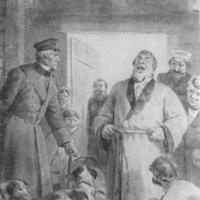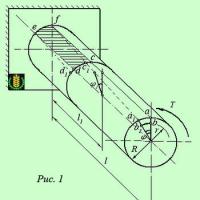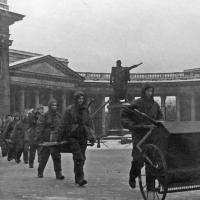Archaeologists divide the history of mankind into the Stone, Bronze and Iron Ages. Using. Archaeological periodization and chronology Archaeologists divide the history of mankind into stone bronze
Archaeologists divide the history of mankind into the Stone, Bronze and Iron Ages. Using the Internet, find out when such a division appeared, what signs underlie it. Create a diagram to illustrate your explanation.
Answers:
In the 19th century the classification of primitive monuments of material culture began, which led to the creation of a scientifically based archaeological periodization, which, by the way, confirmed the correctness of Lucretius's hypothesis. So, the Danish scientist K. Thomsen, relying on archaeological data, introduced the concept of three ages - stone, bronze and iron.
The idea of dividing the prehistoric period of cultural development into the Stone, Bronze and Iron Ages was put forward by the Danish archaeologist Thomsen in 1816-1819 based on the study of the rich archaeological collections of the Danish National Museum. Thomsen argued that these three ages should succeed each other, because stone would not be used for making tools if people had bronze, which, in turn, had to give way to iron. With the accumulation of archaeological finds, this scheme was gradually improved. Initially, the Stone Age was divided into ancient and new - Paleolithic and Neolithic. Later, the Mesolithic, or Middle Stone Age, was added to them.
The division of the prehistoric period into the Stone, Bronze and Iron Ages was put forward by the Danish archaeologist Thomsen in 1816-1819 based on the study of archaeological finds. Thomsen argued that these three ages should succeed each other, because stone would not be used for making tools if people had bronze, which, in turn, had to give way to iron. This theory is confirmed by archaeological excavations. The name of the centuries is characterized by the leading role of the found products from a certain material. Therefore, sometimes a copper age is put before the Bronze Age, since copper is integral part bronze.
I checked the material. Everything is correct!
Archeology is a part of the historical science that studies the past of mankind from material monuments. Archeology is one of the main special historical disciplines and is called upon to form, on the basis of a special group of sources, a general idea of the early history of human society, the main stages and patterns of formation and development of material culture in various regions of the world. It differs from history as such in that it has a different main source, namely, not written monuments, but the remains of material culture.
Therefore, archeology plays a particularly important role in the reconstruction of pre-literate history. Archaeologists study archaic (that is, pre-literate) societies based on material remains - settlements, burial grounds, tools, etc.
The main way to obtain material monuments is to extract, i.e., dig them out of the ground.
Definition of archeology
Archeology- the study of the past of mankind according to material evidence. Some archaeologists are of the opinion that archeology is a branch of a wider scientific discipline. For example, most researchers belonging to the British school consider archeology to be part of history. The course of archeology at many universities in Britain is studied in the departments of history; in others, there are independent faculties of archeology. The archaeologists of the American school, on the contrary, for the most part see archeology as a branch of anthropology, as a result of which the course of archeology is in most cases included in the curriculum of anthropological faculties. Experts in ancient archeology sometimes consider their specialty as a branch of the science of classical antiquities or art history.
However, among archaeologists there is also a widespread view of archeology as an independent discipline, experiencing the stimulating effect of other sciences, but having its own methods, concepts, theories and scientific discoveries. This opinion was developed, first of all, by representatives of the so-called "new archeology" of the 1960s, and it still remains the position of a rather influential minority. Some scientists see in archeology just a set of methods used in historical, anthropological, art history, geographical and some other research. For them, the boundaries of archeology are determined by the methods of obtaining and analyzing material evidence.
Military archeology
During the years of the Great patriotic war Soviet Union and Germany suffered huge losses in manpower. Millions of bodies of Soviet and German soldiers remained on the territory of our country. The remains of a soldier During the hostilities, the burial of the bodies of the dead (both their own and those of others), for obvious reasons, was not given due attention. They were buried hastily, in mass graves, in bomb craters, in broken dugouts. By special order of the government, after the war, special sanitary detachments were created, which collected the remains of soldiers in the most densely populated areas. What could not be collected was plowed up, and a young forest was planted on top. In sparsely populated areas, such as Karelia, the Novgorod region, and others, such actions were not carried out either. To this day, the remains of soldiers in full ammunition are found there, lying on the surface of the earth.
To find and bury all the dead, in my opinion, is unrealistic.
In memory of all the “missing”, a memorial “Tomb of the Unknown Soldier” was created near the Kremlin wall. As you know, an eternal flame burns there and there is a round-the-clock guard. All diplomatic missions are required to go through the process of laying flowers at this monument. That is, the government (those by whose will this memorial was created) fulfilled its duty to the dead and their relatives.
The memory lives to this day and will live even if the gas of eternal fire is turned off.
Remains of a soldier. And yet there is one "but". Namely, the number of unburied remains remained very high. For this reason, since the sixties of the 20th century, unofficial search parties have been operating in many areas of the country where hostilities took place.
Some so-called "black trackers" are engaged in military archeology(by the way, very dangerous and requiring certain knowledge and skills) for the sake of profit (weapons, awards, ammunition, gold teeth, etc. are of high value on the black market). But most of the detachments do this hard work, obeying a noble human feeling - to pay a debt to those who died for the sake of saving our homeland, to give the remains to the earth, with all military honors. Search squad "STROP"
Departure to the Valley of Death It was guided by this feeling that in 2001, on the basis of the club-museum "Line Broken by a Bullet", a search detachment "STROP" was created, and I became its first commander.
We carried out the main excavations in Mozhaisk and In Adzhimushkai, Dmitrovsky district of the Moscow region, as well as in the quarries of the village of Adzhimushkai in the city of Kerch.
Our slogan (as well as the slogan of the entire search movement) was the popular expression of Alexander Suvorov: "The war continues until the last soldier is found." My attitude
Military archeology has become a very strong stimulus for me to think about the meaning of human life. Having read many books about the war, knowing a lot of military poems, I always experienced an emotional upsurge when I came into contact with the remains of soldiers.
How did the archaeological periodization of primitiveness come about?
The Roman poet and thinker Lucretius Carus (I century BC) divided pre-literate history into stone, copper, bronze and iron ages. The scheme of Lucretius is still used by archaeologists. Archeology was finally formed as a science in the 19th century. During this period, the ancient civilizations of Mesopotamia and Egypt were discovered. In 1836, the Danish archaeologist X. Thomsen in his book "Guide to the Northern Antiquities" substantiated the hypothesis of three centuries of the initial history of mankind with archaeological material, it was confirmed and developed by I. Vorso. The French archaeologist E. Larte established that the man who made the oldest stone tools was a contemporary of the mammoth and other fossil animals. In 1862, Lord Avebury, D. Lebbock, proposed dividing the entire "prehistory" of man into 2 parts: the first was called the Paleolithic, which means "ancient stone age" in translation, and the last - the neolithic (new stone age). Pottery already appeared in the Neolithic.
The French archaeologist Gabriel de Mortillet proposed to divide the Paleolithic into 2 large periods - upper and lower. The Upper (Late) (40-12 thousand years ago) Paleolithic age included finds from the upper layers of sites ancient man, and to the lower (early) - from the deeper ones. He divided the Lower Paleolithic (older than 40 thousand years) into 3 more parts - Shell, Acheul and Mousterian, and the upper - into Aurignac, Solutre and Madeleine. These names were given according to the names of places in France where tools of one or another period were first found, these names then spread throughout all countries - now finds are attributed to Acheulean and Mousterian not only in France, but also in Asia, Africa and other countries. Shell is not used now, but the term "olduvai" has been introduced. At the end of the XIX century. the French archaeologist E. Piet discovered the transitional era between the Paleolithic and the Neolithic - the Mesolithic - the Middle Stone Age.
The Bronze and Iron Ages were also divided into two periods - early and late. At the end of the XIX century. in archeology, the Ter-"Eneolithic" appeared, that is, the Copper-Stone Age, the transitional period from the Stone Age to the Bronze Age. In the Iron Age, the period of early iron, ancient and medieval archeology is distinguished.
How are archaeological excavations carried out?
To excavate means, as it were, to raise the entire thickness of the earth, which for centuries and millennia was applied by winds, streams of water, layered with the remains of decaying plants, to raise so as not to disturb everything that was left, lost or abandoned in bygone times. The layer of earth above the remains of abandoned settlements and other traces of human life is growing even now, every year and every day. According to experts, at present, 5 million cubic kilometers of rock annually rises into the air, and then settles. The waters erode and carry more soil from place to place.
“Archaeology is the science of the shovel,” old textbooks say. This is not entirely accurate. You have to dig not only with a shovel, but also with a knife, a medical scalpel and even a watercolor brush. Before starting excavations, the surface of the monument is divided with the help of pegs into equal squares of 1 (1 x 1) or 4 (2 x 2) m2. Each peg is numbered and put on the plan. All this is called a network. The grid helps to record finds on plans and drawings. During excavations, all work is done manually. It is still impossible to mechanize this difficult, delicate and responsible business. Only the removal of earth from the excavation is mechanized.
Very often there are multi-layer monuments - usually these are places in which people settled more than once. In Central Asia and the Middle East, where adobe houses were built from raw bricks, the ruins of ancient cities layered on top of each other formed hills several tens of meters high - telli. It is difficult to understand such a multi-layered monument. But it is even more difficult to stratify those ancient settlements where houses were built of wood. From such settlements, only a thin layer of decayed remains of wood, ash, coals and incompletely decayed organic remains remains. This layer of dark color is clearly visible in the wall of a collapsing ravine or in the edge of a washed-out river bank. In archeology, such a layer is called a cultural layer, since it contains the remains of one or another ancient human culture. The thickness of the cultural layer is different. In Moscow, during the construction of the metro, it was found that in the city center it reaches 8 m, and in the Sokolniki district it is only 10 cm. On average, 5 m of the cultural layer was deposited in Moscow over 800 years. At the Roman Forum, the thickness of the cultural layer is 13 m, in Nishgur (Mesopotamia) -
20 m, in the settlement of Anau (Central Asia) - 36 m. Above the Paleolithic sites in Africa - hundreds of meters of stone. At the Karatau site in Tajikistan, 60 m of clay above the cultural layer.
Ancient people dug dugouts, pits for storing food, recesses for fires, without caring, of course, about the safety of the cultural layer for archaeologists. In order to better understand the stratigraphy (alternation of layers) of the monument, narrow strips of untouched areas - brows - are left between the squares. After the completion of the excavations, one can see from the brows how one cultural layer is replaced by another. Eyebrow profiles are photographed and sketched. Between the brows, the earth is simultaneously removed in layers of no more than 20 cm over the entire excavation area.
The work of an archaeologist can be compared to that of a surgeon. A small slip results in the death of an ancient object. During excavations, it is necessary not only not to damage the finds, but also to conserve them, save them from destruction, describe everything in detail, photograph, sketch, draw up a plan of ancient structures, stratigraphic profiles of excavations, accurately mark the sequence of alternation of layers on them. It is necessary to take all kinds of materials for analysis, etc.
Where were the earliest stone tools discovered?
In 1931, an African scientist of English origin, Louis Leakey, began excavations in the Olduvai Gorge in East Africa. He found the first stone tools seven hours after his arrival in Olduvai. Over the decades of excavation, many such tools have been found. They met here at different depths: sometimes at the very surface, sometimes at a depth of 100 m. 4 multi-colored layers were clearly visible. At the very top, Late Paleolithic tools were found. Below, to a depth of 45 m, are the tools of Pithecanthropus. This was layer IV. The layers were counted from the bottom up, and the tools of layer IV were the same as those found in France, near the city of Ashel. They are called Acheulean. Until now, they were considered among the most ancient. However, here they lay at the very top of the cultural layer. And below them were 3 more layers with tools and animal bones. In the 15-meter layer III there were Acheulian axes. 30 m deeper than it is layer II. On top of layer II there were still axes, and below there were tools of a different type. Leakey called them choppers, which in English means "knife, cleaver." They were pebbles, slightly pointed at one end.
In the lowest layer, at a depth of almost 100 m, there were also tools and animal bones. The thickness of the layer here was also impressive - 40 m. In layer I, choppers and chops were also found, only coarser than in layer II (choppings are called tools, chipped on both sides, and choppers - on one side). No one has ever found such ancient tools anywhere. And they called them Olduvai. So a new culture entered science - Olduvai. Some scientists began to say that choppers and choshgings were not tools, but accidentally chipped stones. What can be done with such primitive tools? And how were they made?
Leakey began to learn how to make such tools. And he got the hang of it so that in 4 minutes he beat the pebbles and made a chopper. Once Leakey, in the presence of numerous witnesses and at the point of view of cameras, began to work with ancient tools. Only 20 minutes passed, and he not only killed the ram, but also skinned it and cut the carcass into pieces. And he did all this with only choppers and chopping.
Answered by: Guest
Diggers (English diggers, literally - diggers), representatives of the extreme left wing of revolutionary democracy in the English bourgeois revolution of the 17th century, expressing the interests of the rural and urban poor, especially landless and landless peasants, who were ruined during the agrarian revolution and were subjected to both feudal and capitalist operation. The name D. first appeared during the peasant uprising of 1607 in central England, but as an ideological and socio-political trend, D. took shape during the revolution, at its bourgeois-democratic stage (1647-49), standing out from the Leveller movement (in contrast to from which D. began to call themselves also "true Levellers"). The D., through the mouth of their ideologist J. Winstanley, proclaimed the ideal of a "free republic" that does not know the exploitation of man by man, the ideal of collective property and collective labor. The D. program provided for the abolition of copy-gold and the power of manorial lords over land, and the return of communal lands to common use. The implementation of this program would mean the complete abolition of feudal landownership and, ultimately, private ownership of land. Given the far-reaching differentiation of the English peasantry, the demands of the Democrats could not become the basis of a mass movement in the countryside. In 1649, the Danes undertook an attempt at collective cultivation of the communal wasteland near Cobham (County of Surrey) and other places. However, legal persecution and direct violence by the authorities ultimately undermined the D. movement (1650).
Answered by: Guest
The morning was gray and gloomy. We were picked up at dawn. Reluctantly, I got up and went to the gathering place, voices were already coming from there. “What kind of life, Stepan Timofeevich”? .. said the elder. “There is nothing to live with. The sovereign's salary in duvan went to a kus per person, and to others and two - kus. Do you feed on this? Tea, we must go to the Volga. Stepan listened to the elected ones, and took command of the poor. He ordered to equip the plows and set sail on the Volga. Closer to noon, we were informed that a plow of the Moscow rich Shorin with bread, a patriarchal plow and other boats were moving along the Volga. The archers accompanied the caravan. It was decided to sneak up to the caravan unnoticed and capture it with a sudden blow. The detachment of Cossacks in which I was, was ordered to kill the guards, consisting of archers. We swam out of the thicket and, with a shout and a whoop, rushed across the caravan, then everything that happened was in a fog. Our Strug rammed the boat in which the archers were. The boat capsized and the archers, screaming and cursing, ended up in the water. Those who did not know how to swim immediately went to the bottom, and those who knew how to finish off with squeakers, and those who clung to the plow were stabbed with boot knives. The day was drawing to a close. The loot was divided among the Cossacks. I got good cloth and some bread. Not a bad start. We settled on the shore. I slowly fell asleep to the songs of the Cossacks...
Answered by: Guest
The 19th century is called the "Golden Age" of Russian poetry and the century of Russian literature on a global scale. It should not be forgotten that the literary leap that took place in the 19th century was prepared by the entire course of the literary process of the 17th and 18th centuries. The 19th century is the time of the formation of the Russian literary language, which took shape largely thanks to A.S. Pushkin.
But the 19th century began with the heyday of sentimentalism and the formation of romanticism. These literary trends found expression primarily in poetry. Poetic works of poets E.A. Baratynsky, K.N. Batyushkova, V.A. Zhukovsky, A.A. Feta, D.V. Davydova, N.M. Yazykov. Creativity F.I. Tyutchev's "Golden Age" of Russian poetry was completed. However, the central figure of this time was Alexander Sergeevich Pushkin.
A.S. Pushkin began his ascent to the literary Olympus with the poem "Ruslan and Lyudmila" in 1920. And his novel in verse "Eugene Onegin" was called an encyclopedia of Russian life. Romantic poems by A.S. Pushkin's "The Bronze Horseman" (1833), "The Fountain of Bakhchisaray", "Gypsies" opened the era of Russian romanticism. Many poets and writers considered A. S. Pushkin their teacher and continued the traditions of creating literary works laid down by him. One of these poets was M.Yu. Lermontov. His romantic poem "Mtsyri", the poetic story "Demon", many romantic poems are known. Interestingly, Russian poetry of the 19th century was closely connected with the social and political life of the country. Poets tried to comprehend the idea of their special purpose. The poet in Russia was considered a conductor of divine truth, a prophet. The poets urged the authorities to listen to their words. Vivid examples of understanding the role of the poet and influence on the political life of the country are the poems of A.S. Pushkin "Prophet", ode "Liberty", "The Poet and the Crowd", a poem by M.Yu. Lermontov "On the Death of a Poet" and many others.
Along with poetry, prose began to develop. The prose writers of the beginning of the century were influenced by the English historical novels of W. Scott, whose translations were very popular. The development of Russian prose of the 19th century began with the prose works of A.S. Pushkin and N.V. Gogol. Pushkin, under the influence of English historical novels, creates the story "The Captain's Daughter", where the action takes place against the backdrop of grandiose historical events: during the Pugachev rebellion. A.S. Pushkin did a tremendous job exploring this historical period.
 Invariant mass Relativistic mass formula
Invariant mass Relativistic mass formula Chapter II: Lawlessness in Court
Chapter II: Lawlessness in Court Healthy recipes with thousands of years of history for modern life”
Healthy recipes with thousands of years of history for modern life” Moment of inertia for parallel movement of axes
Moment of inertia for parallel movement of axes Audio Automation File s Audio Automation File s
Audio Automation File s Audio Automation File s "Iron Curtain" by Pavel Ryabushinsky
"Iron Curtain" by Pavel Ryabushinsky "Architectural appearance of besieged Leningrad
"Architectural appearance of besieged Leningrad